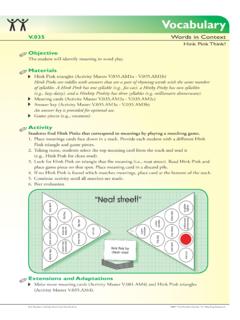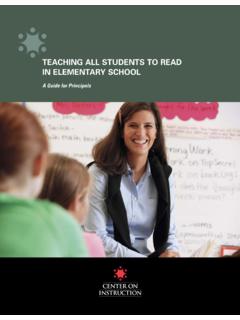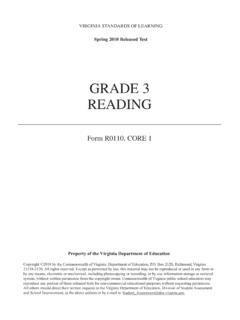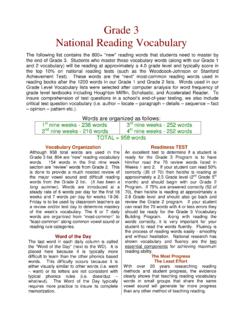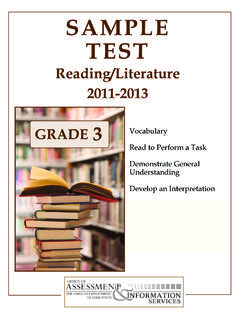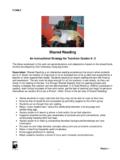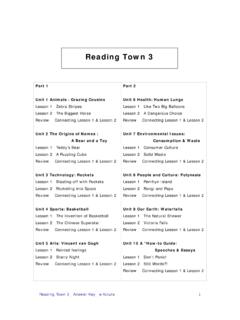Transcription of EXTENSIVE READING INTERVENTIONS IN GRADES K– 3
1 EXTENSIVE READING INTERVENTIONS . IN GRADES K 3. From Research to Practice EXTENSIVE READING INTERVENTIONS . IN GRADES K 3. From Research to Practice Nancy Scammacca, Sharon Vaughn, Greg Roberts Vaughn Gross Center for READING and Language Arts The University of Texas at Austin Jeanne Wanzek, Joseph K. Torgesen Florida Center for READING Research Florida State University 2007. The authors would like to acknowledge the valuable assistance given in the preparation of this document by Lynn Fuchs and Patricia Mathes. This publication was created for the Center on Instruction by the Vaughn Gross Center for READING and Language Arts at the University of Texas at Austin.
2 The Center on Instruction is operated by RMC Research Corporation in partnership with the Florida Center for READING Research at Florida State University; Horizon Research, Inc.;. RG Research Group; the Texas Institute for Measurement, Evaluation, and Statistics at the University of Houston; and the Vaughn Gross Center for READING and Language Arts at the University of Texas at Austin. The contents of this document were developed under cooperative agreement S283B050034 with the Department of Education. However, these contents do not necessarily represent the policy of the Department of Education, and you should not assume endorsement by the Federal Government.
3 The Center on Instruction requests that no changes be made to the content or appearance of this document. Preferred citation: Scammaca, N., Vaughn, S., Roberts, G., Wanzek, J., &. Torgesen, J. K. (2007). EXTENSIVE READING INTERVENTIONS in GRADES k 3: From research to practice. Portsmouth, NH: RMC Research Corporation, Center on Instruction. To download a copy of this document, visit TABLE OF CONTENTS. 1 EXECUTIVE SUMMARY. 3 INTRODUCTION. 5 METHODOLOGY AND CRITERIA. FOR SELECTING AND ANALYZING STUDIES. 9 BRIEF NARRATIVE SUMMARIES OF EXTENSIVE INTERVENTIONS . 29 IMPLICATIONS FOR PRACTICE. 32 TABLE 1. ESTIMATED PERSONNEL COST PER STUDENT.
4 OF PROVIDING EACH INTERVENTION. 33 DETAILED SUMMARIES OF RESEARCH STUDIES. 64 TABLE 2. STUDY CHARACTERISTICS. 66 TABLE 3. EFFECT SIZES BY MEASURE AND GROUP COMPARISON. 75 REFERENCES. EXECUTIVE SUMMARY. The report summarizes relevant high-quality research studies and synthesizes their findings to determine the relative effectiveness of INTERVENTIONS for struggling early readers. Additionally, we outline the implications of these findings for practice. Specific suggestions for implementing the findings are discussed in detail beginning on page 29; they are briefly listed below. 1. EXTENSIVE INTERVENTIONS can be effective even when provided by relatively low-cost implementers when appropriate training is provided and the INTERVENTIONS are fairly structured and delivered one-on-one or in groups of two or three students.
5 2. In studies that included a follow-up assessment, gains from early EXTENSIVE INTERVENTIONS appear to be maintained over time, at least into second grade. 3. All of the effective early INTERVENTIONS examined in these studies shared four essential elements: training in phonological awareness, decoding, and word study; guided and independent READING of progressively more difficult texts; writing exercises; and engaging students in practicing comprehension strategies while READING text. 4. Other elements of these INTERVENTIONS that may be related to their success include group size (one-on-one, small group), the daily or near-daily frequency of the intervention sessions, and the early identification (in K or Grade 1) of students in need of intervention.
6 These elements were evident though not directly tested in most relevant research studies. 5. We know considerably more about the effectiveness of early INTERVENTIONS than we do about INTERVENTIONS provided at later stages of development. 6. Considerably more research is needed on students whose response to treatment is relatively low. Most of these implications apply best to students who are judged to be among the 20% to 25% most at risk for READING problems at the beginning of kindergarten, first, or second grade. As the research intervention literature extends to more severely disabled students, these conclusions may need to be modified.
7 1. INTRODUCTION. As school personnel implement response to intervention (RTI) models, many issues related to effective intervention practices arise. Because the law requires INTERVENTIONS to be based on the best scientific research currently available, it is important to synthesize and present current research findings on INTERVENTIONS to make the best research accessible to educational practioners responsible for implementing RTI models in the field. Within the RTI model, many students who are at risk for READING problems or disabilities may require EXTENSIVE INTERVENTIONS . In fact, questions about the required duration or intensity of preventive INTERVENTIONS for young students are among the important unresolved issues related to implementing the RTI model.
8 At present, there is insufficient research to provide clear guidance about the duration or intensity of INTERVENTIONS that might be required for individual students. However, by acquiring information about the average effects of INTERVENTIONS of varying lengths, schools may begin to develop a deeper understanding of the characteristics of INTERVENTIONS they will need to provide to achieve their goals in preventing early READING difficulties. In the current analysis, we present information about a set of clearly described EXTENSIVE INTERVENTIONS , defined for the purposes of this paper as INTERVENTIONS that provided for at least 100 instructional sessions.
9 Of course, the number of instructional sessions is only one dimension of extensiveness relevant to the description of INTERVENTIONS . Other important dimensions might include the breadth of instructional content, or the teacher's skill and training, or the size of the instructional group. However, we considered the number of sessions to be a measurable criterion that allows for synthesis and represents the way in which many schools will implement these types of INTERVENTIONS . We view this as a starting point in understanding the knowledge base about EXTENSIVE INTERVENTIONS for students at risk for READING difficulties and disabilities.
10 The purpose of this report is to increase the knowledge of those working with or in state departments of education and local education agencies on READING -related issues for primary-grade students at risk for READING difficulties and learning disabilities. The report includes a narrative summary of research studies, a synthesis of their findings to determine the relative effectiveness of 3. INTERVENTIONS for struggling early readers, and an outline of the implications of these findings for practice. While we describe our methods and general findings, we present them in terms of their impact on practice and policy. Specific suggestions for implementing these and other research findings appear in the last section of this document.
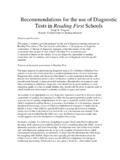
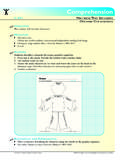
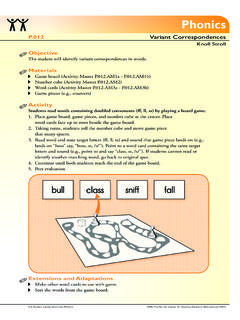
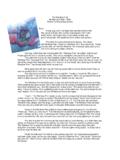
![Assessments for Secondary Students.ppt [Read-Only]](/cache/preview/9/8/f/2/d/f/a/0/thumb-98f2dfa0f0af200f0fe379df10741ab3.jpg)
